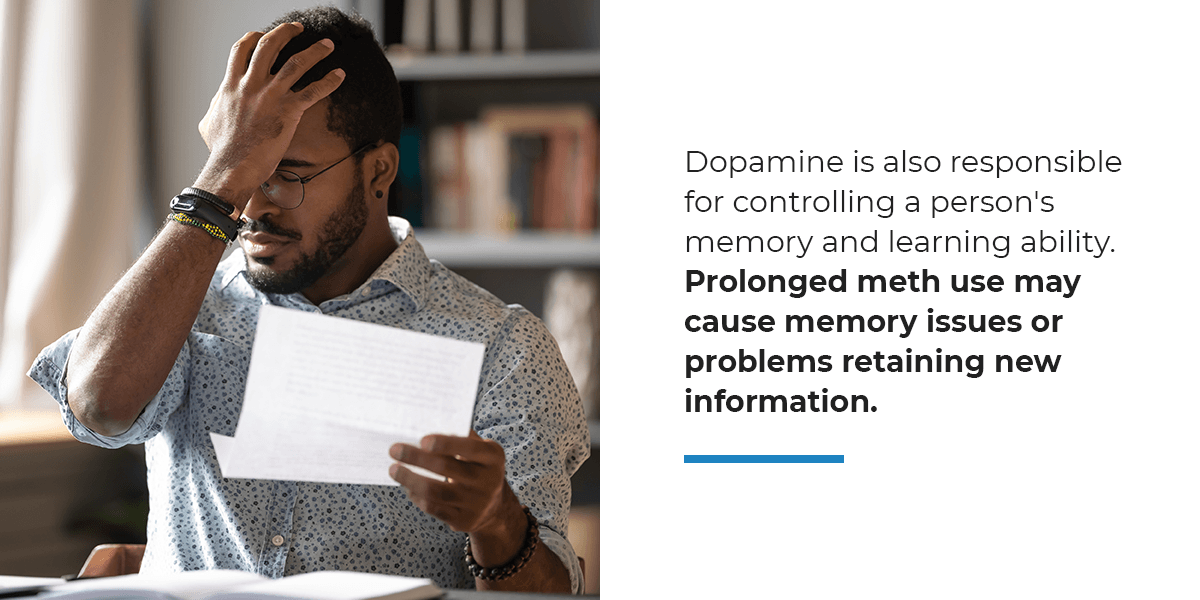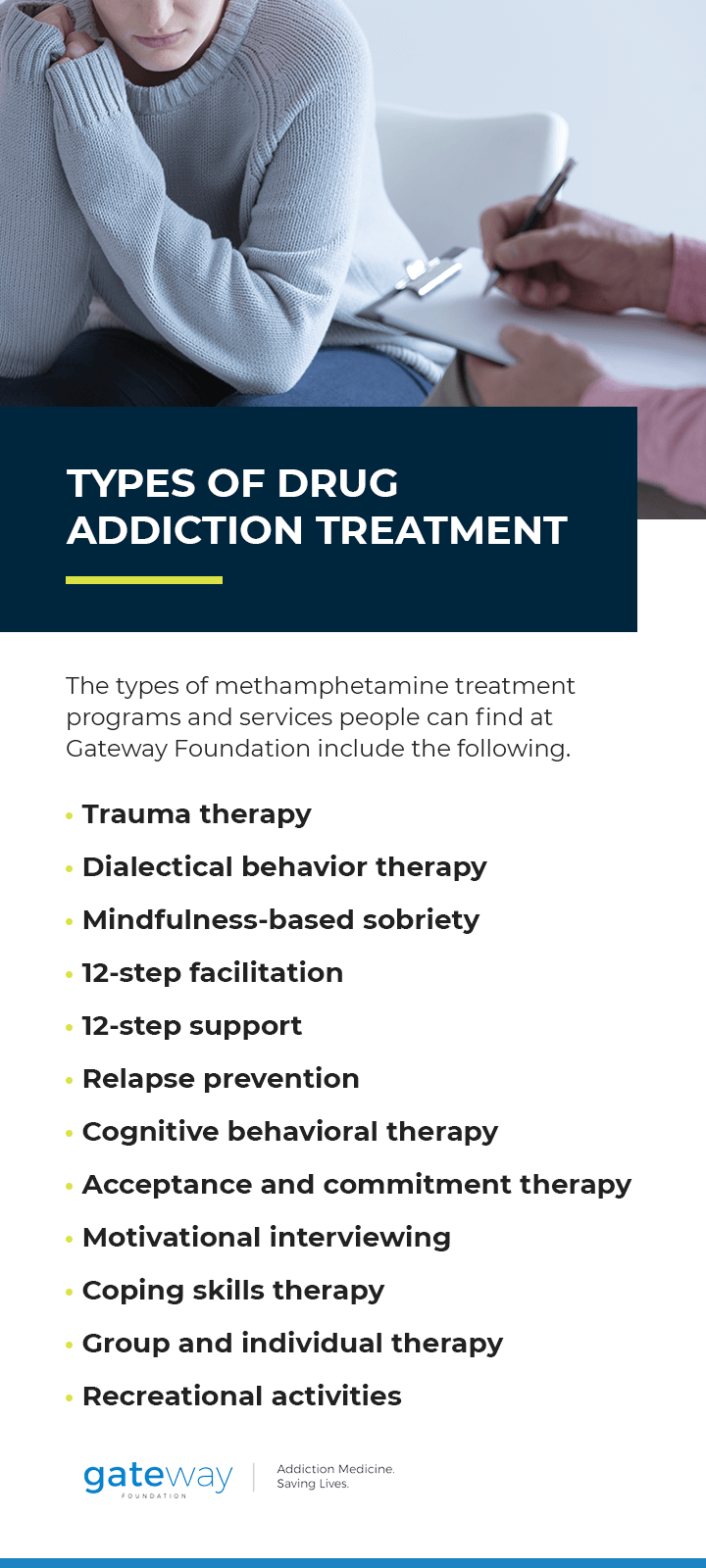
Substance use in the United States continues to impact people from all backgrounds, ethnicities and gender identities. Around 11.7% of people 12 years old and older use illicit drugs in America.
People may try different drugs and never develop a dependence or addiction, while others are more likely to struggle with substance use disorders — chronic conditions that limit their control over how much they use. As their illness worsens, they’ll feel physical and mental pulls to their substance of use and start devoting most of their time to it.
Methamphetamine, or crystal meth, is one of the most commonly misused and harmful substances nationwide. Learn more about crystal meth and where you can find treatment for crystal meth addiction for yourself or a loved one.
Methamphetamine is a potent, highly addictive synthetic stimulant. Meth impacts the central nervous system and can produce various physical and psychological symptoms.
The common street names for methamphetamine include:
Meth is colorless or white in appearance. It’s typically in crystal or powder form, tastes bitter and is odorless. Medical uses may include treating attention deficit disorder and helping with weight loss, though doctors may be reluctant to prescribe stimulants due to their high potential for abuse. The United States Drug Enforcement Administration lists methamphetamine as a Schedule II drug, which means it can lead to intense physical and psychological dependence. Meth is accessible and inexpensive to buy illegally, which drives its use.
According to the National Institute on Drug Abuse, scientists derived methamphetamine from the drug amphetamine in the early 20th century. The first medical uses for methamphetamine were in bronchial inhalers and nasal decongestants. The effects of methamphetamine and amphetamine include reduced appetite, increased energy and talkativeness and a rush of euphoria. The primary difference between the two related drugs is that much larger quantities of methamphetamine affect the brain, making it more harmful and increasing its potential for abuse.


Battling crystal meth addiction is hard. We’re here to help you win back your life.
If you or a loved one is misusing methamphetamine, telltale signs can indicate a worsening problem. Being aware of the common warning signs of methamphetamine use can help individuals seek the help they need for substance use disorder or conquer their meth dependency.
Meth can impact a person’s mind and body. Check out all the physical, behavioral and psychological indicators of meth substance use if you’re concerned about a family member, friend or yourself.
A person who is new to using meth or any substance will experience its effects throughout their body. The physical signs can sometimes be the most shocking because meth use can drastically alter someone’s appearance. After prolonged methamphetamine use, you can go from looking healthy to frail and sickly. The range and severity of physical symptoms vary depending on how long someone uses meth and the dosage they take.
These red flags can show a growing dependency on meth as the symptoms increasingly worsen. Look out for the following physical symptoms of methamphetamine use:
Meth use will also alter a person’s appearance because it harms or constricts the blood vessels throughout the body. As a result, blood will not circulate fully, causing vessels to become weak or damaged beyond repair. Damaged blood vessels can cause the skin and tissue to have trouble repairing themselves, making a person’s appearance look weak with prolonged use.
The stimulant causes a flood of dopamine and adrenaline, creating an intense and heightened libido. The increased sex drive that can occur with meth use is another dangerous physical symptom because it may lead to unprotected sexual encounters, potentially putting people at risk for contracting STDs.
Behavioral changes are another top aspect to look out for when confirming whether someone is struggling with methamphetamine use.
As a substance use disorder worsens, meth use can transform from recreational to a necessity for functioning throughout the day. This dependency can lead to a significant change in someone’s behavior because they will crave meth and start having less control over when and how much they use. Crystal meth use can impact all areas of a person’s life, including work, school, family functions and close relationships. In the early stages of substance use, a person may successfully hide their problems and appear to be high-functioning. As use progresses, crystal meth behavior changes like these become more apparent and harmful.
Another red flag of meth use is finding paraphernalia like small bags, pipes, syringes, lighters, glass tubes, straws and aluminum foil. It’s more likely to discover these items rather than the drug itself.

Any substance can produce psychological effects that impact a person’s dependency on the drug. With methamphetamine, the stimulant has powerful mental and emotional symptoms that can alter a user’s overall health and wellness.
The first thing methamphetamine use will do to your brain is increase the amount of dopamine and other chemicals released, producing a potent euphoric or high feeling. Dopamine is the primary messenger for the brain’s reward system, which creates a positive, self-sustaining feedback loop. Over time, the positive feelings associated with meth use will become more intense and cause cravings when you are sober.
Dopamine is also responsible for controlling a person’s memory and learning ability. Prolonged meth use may cause memory issues or problems retaining new information.
Other psychological issues to look out for include:
Pleasurable feelings are a significant driver of substance misuse. The false feelings of well-being or happiness can overshadow some adverse health effects for some time, but not forever. While a person continues to use a drug like meth, their overall health will begin to deteriorate. The first effects may seem insignificant or only last for a short time, but the longer a person uses meth, the more severe the physical and psychological health effects can be.
Learn more about the short- and long-term health effects of meth and why finding treatment quickly is essential to gaining a new healthier lifestyle without drugs.
At the beginning of a person’s meth use, they may repeatedly push their body to its limits to feel the sense of euphoria the substance produces. This continual over-exertion of energy can start making unwanted health changes. As cravings for meth start to increase and drug use ramps up, these short-term effects become more prevalent. Short-term health effects may even appear after the first use. The harmful changes to different systems vary among people.
The short-term effects of meth include:
Prolonged use of methamphetamine can gradually lead to more severe and long-term effects. One of the most prominent things that can occur with continual meth use is addiction. A substance use disorder progresses when people choose to ignore the drug’s adverse effects on their bodies or are not aware of them until they cause permanent damage.
Among all the other physical and psychological ramifications of prolonged methamphetamine use, the brain may experience the most drastic changes. Drug use alters the innate reward system and may impair brain function and development, including emotional regulation and memory.
The National Institute on Drug Abuse has completed studies that show methamphetamine changes the dopamine system and impacts verbal learning and motor skills speed.
Prolonged meth or crystal meth use can also lead to various physical health effects, from problems with a person’s dental health to an increased risk of developing other chronic conditions. People must seek treatment if they start to experience any of these more intense health effects.
Physical health effects may be the most noticeable at first, but people may notice other life changes because of meth use. These changes include:


Battling crystal meth addiction is hard. We’re here to help you win back your life.
Since the street versions of methamphetamine come in various forms, people can use different methods to misuse the substance. Individuals can inject, smoke, snort or orally consume meth.
Orally ingesting or snorting meth will gradually create a euphoric feeling. Snorting this substance will have a noticeable effect in about three to five minutes, and oral consumption will take effect in 15 to 20 minutes.
Injecting or smoking meth will produce an intense rush because of its quick delivery to the brain and bloodstream. This powerful onset of symptoms can increase the addiction risk. Since the rush is almost immediate, the high only lasts for a few minutes.
This stimulant’s characteristics lead people to use methamphetamine in a binge-and-crash routine. The quick and intense symptoms make users want to continue the high by taking more meth, sometimes for days, until they eventually crash.

Meth rehabilitation centers like Gateway Foundation offer numerous clinical services and therapy programs that can help individuals throughout their recovery process. Gateway strives to develop a meth treatment plan that fits every person’s wants and needs, and the various treatment options allow our patients to benefit from a unique approach.
The types of methamphetamine treatment programs and services people can find at Gateway Foundation include the following.
Substance use disorders’ severity differs for every person, which is why Gateway Foundation offers different levels of care to ensure every patient receives the high-quality attention they deserve.
With our full continuum of care, patients can transition into different therapeutic methods that still cater to their needs. People requiring less hands-on care can move down a level and vice versa.
Learn more about the different levels of care at Gateway Foundation and see how patients can have a successful recovery process at every stage.
Meth withdrawal symptoms like jitters, fatigue, intense cravings, depression, hallucinations and paranoia can be unpleasant and frightening. The first step for many people in recovery is to conquer the withdrawal process. The withdrawal management program at Gateway Foundation can help people safely and effectively make their way through withdrawal symptoms.
The withdrawal management and detoxification program provides around-the-clock supervision from medical professionals to help you quickly and safely move through withdrawal. Some patients may require crystal meth medication-assisted treatment, which helps reduce some of the intense withdrawal symptoms of methamphetamine use.
People who need a safe space for ice drug rehab with 24/7 supervision and no access to meth can benefit from residential inpatient treatment. Cravings for meth can be challenging to ignore during treatment. Residential treatment programs ensure patients have no access to substances and are living in a place that doesn’t remind them of their lifestyle surrounding methamphetamine misuse. patients will live at the residential facility and have access to mental health and medical professionals at nearly any time during their stay. Residential treatment can also provide peace of mind to families and friends because they’ll know their loved one is safe and professionals are looking after their needs.
patients who need optimal supervision and treatment services during the day can benefit from partial hospitalization programs. This level of care is an excellent stepping stone after residential inpatient treatment or a replacement to outpatient treatment for those who need more assistance.
PHP will have a similar schedule to work or school, taking up the bulk of your daily time throughout the week. In the evening, you can return home and sleep in your bed. This program will provide patients with a day full of helpful treatment programs, therapies and support from the staff at Gateway Foundation.

Those who are stable enough to continue living at home and need to get back to work, school or other obligations can benefit from outpatient treatment. This option allows patients to have the flexibility they need to maintain their typical routine and responsibilities while still participating in their treatment program. People can schedule their outpatient treatment appointments at any time during the week. The goal is to allow them to fit appointments into their schedules and continue offering commitment and support from the staff at Gateway Foundation. patients may also participate in support groups to start preparing for life after treatment.
Jumping back into regular life can be challenging for individuals after leaving the structure and routine of a treatment program. Gateway Foundation offers sober living options and ongoing support through various programs to help people transition more easily into the real world.
Sober living homes are an excellent turning point. These homes will ensure people follow the rules and continue taking steps toward a sober lifestyle with support from others going through a similar situation.
Residents can also benefit from ongoing care, like our 12-step support program and other groups that help prevent relapse after treatment.
Seeking treatment is the best thing a person can do for yourself or a loved one struggling with substance use disorder. Check out the four benefits of finding a methamphetamine rehab center:
Do you have more questions regarding crystal meth rehab and treatment? Check out these frequently asked questions to learn more.
The laws vary by state, but people caught with meth can be arrested, sentenced to prison or face financial and legal troubles.
Meth can appear as a clear crystal drug or a white or yellow powder.
Look for the different signs and symptoms of meth use listed on this page to determine if someone is using meth.

Anyone can develop a substance use disorder, regardless of beliefs or background. This condition causes the brain to react differently to substances like methamphetamine and can lead people to become addicted. Addiction does not demonstrate a lack of willpower or strength, but rather a person who is battling a disease and needs help through rehabilitation and treatment. While there isn’t one cause for substance use disorder, several factors can make someone more vulnerable to developing an addiction.
These five variables can contribute to a person’s risk for developing an addiction — genetics, environmental, early use, dual diagnosis and drug choice. Learn more about these factors and see how they can affect someone’s likelihood of developing an addiction to methamphetamine.
Some people can misuse drugs and never develop an addiction, while others may quickly develop a tolerance and dependency. Genetic differences are one possible reason for this.
People with immediate family members like parents or grandparents who suffer from substance use disorder have a higher chance of also developing the condition. Addiction stems from chemical reactions in the brain, and people who are more prone to substance abuse have differences in their brain structures compared to those who don’t develop a drug problem.
Being genetically prone to substance use disorder means a person may develop an addiction to any substance, not necessarily the same one their relative has a dependency on.
Environmental factors, like someone’s childhood or current surroundings, will affect their risk for substance use disorder. We especially see this phenomenon among young teens or children who grow up with limited parental guidance. Children whose parents take a less active role in their lives may be more likely to experiment with substances like methamphetamine due to peer pressure.
Physical location may also play a role in someone’s risk for substance use. For instance, if drugs are easily accessible in your community, you may be more likely to experiment with various substances and develop a habit.
Another environmental aspect to consider is a person’s exposure to trauma or abuse. Trauma can often be the root of substance use disorder or cause people to use drugs to self-medicate their pain.
The earlier someone begins experimenting with drugs or alcohol, the more their likelihood of developing a substance use disorder can increase. The brain is still completing critical development processes into adulthood, and substance use can hinder this process and potentially lead to memory, learning or decision-making issues.
Early use may also increase a person’s chances of developing a mental health condition. Substance use disorders can lead to various mental health conditions, and experimenting with drugs in adolescence can heighten the chances for both conditions.
Dual diagnosis and co-occurring disorders are other factors that increase a person’s risk level for addiction. Dual diagnosis describes the simultaneous occurrence of a mental health condition and a substance use disorder. Either problem can lead to the other.
It’s possible for people who have a mental health condition like generalized anxiety disorder, bipolar disorder or depression to turn to substance use as a coping mechanism. Unfortunately, using meth to reduce the symptoms of a mental health condition may make these symptoms worse.
The substance a person uses can impact their risk level for substance use disorder. Methamphetamine is more physically addictive than many other substances because of its effects and how it interacts with the brain. Meth’s unpleasant withdrawal symptoms and cravings also make it more likely that people will return to substance use, even if they feel motivated to quit.


Don’t let your addiction continue to poison your life. Start your recovery journey today.
Meth can severely impact communities where it has established a foothold. Since crystal meth is a human-made substance consisting of medications and other chemicals, people “cook” it in places called meth labs. These illicit operations use equipment to create the drug in mass amounts. A meth lab can be a vast operation employing dozens of people or a small, one-person job in someone’s home. Regardless of a meth lab’s size, it can adversely affect the surrounding area.
Meth labs have popped up nationwide, from rural communities to large cities. Law enforcement officers have discovered people making meth in various locations, like hotels, private residences, outdoor structures, boats and cars.
The most dangerous part of a meth laboratory in any community is the hazardous chemicals used to make the substance. These are highly flammable, and meth labs can explode if people mix chemicals carelessly or store them improperly. The fire created by the explosion is dangerous, but the release of toxic chemicals also poses a health risk to the people living nearby the meth laboratory. Some possible issues from these chemicals include disorientation, nausea, chemical burns, organ damage, dizziness and respiratory problems.
If you suspect a meth laboratory is in your community, look for these warning signs:
Determining whether you or a loved one requires treatment may require careful consideration of the behavior surrounding crystal meth and its overall effects on quality of life. The first thing to do is determine whether you or someone you care about is struggling with a meth dependence or addiction.
You may hear the terms “addiction” and “dependency” used interchangeably, but the two describe different health occurrences. In short, dependence is a physical or mental craving while addiction is a chronic condition. Check out the notable distinctions between the two terms to help understand when it’s time to seek treatment for meth use.
Physical, social and mental signs can indicate when someone requires a meth treatment program. These signs include:


Receive high-quality care for methamphetamine addiction treatment from Gateway Foundation, one of the nation’s leading rehab facilities. With 16 locations in Illinois to choose from, patients can find a nearby treatment center to start their recovery process. Contact us today to learn more about our programs and services for achieving lifelong freedom from meth abuse.
We use cookies to give you the best experience on our website. If you continue without changing your cookie settings, we assume that you consent to our use of cookies on this device. You can change your cookie settings at any time but if you do, you may lose some functionality on our website. More information can be found in our Privacy Policy.